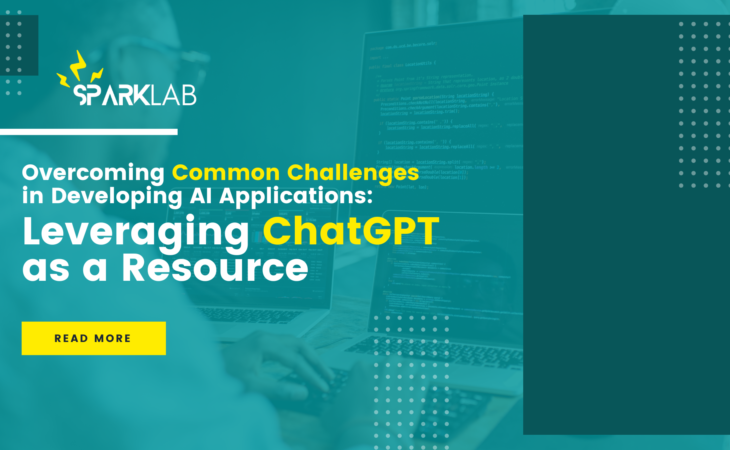
AI applications are spreading across industries, transforming industries such as healthcare, finance, and manufacturing. However, implementing AI applications poses difficulties that can impede progress.
In this post, we will look at frequent obstacles in AI application development and examine effective solutions, with a focus on exploiting ChatGPT as a helpful resource.

Traditional software development and AI development are two unique methods of application development.
While both aspire to develop functional and valuable solutions, their fundamental concepts, approaches, and problems differ greatly.
In this section, we will look at the fundamental differences between normal development and AI development.
The emphasis in traditional software development is mostly on applying a predefined set of rules and methods.
Developers examine the problem domain, create a solution based on proven approaches, then develop code to implement it. Deterministic procedures and logical thinking are emphasized.
The approach to AI development is fundamentally different. AI systems learn and adapt from data rather than explicitly stated rules.
Machine learning algorithms, such as neural networks, examine patterns and make predictions or judgments based on what they have learned.
Also, AI development entails the training of models, the optimization of algorithms, and the constant improvement of performance through data-driven procedures.
Traditional development uses structured data and preset decision-making criteria.
Developers create algorithms that process input and generate outputs based on defined rules and circumstances. The coded logic drives deterministic and predictable decisions.
AI development is primarily reliant on data. To generate predictions, classify information, or automate processes, AI systems learn from vast amounts of data.
Plus, the decision-making process is probabilistic, with statistical models and patterns revealed in the data serving as the foundation.
As they meet more data, AI systems adapt and develop, allowing them to handle complicated and confusing situations.
Traditional software solutions are built with a predefined set of features and functionalities in mind.
More so, they are often static and necessitate manual updates or alterations to accommodate changes. Flexibility and adaptability are attained through meticulous design and upkeep.
AI applications provide increased adaptability and versatility. Artificial Intelligence models’ learning skills allow them to adapt to new data, handle changes, and generalize knowledge to previously encountered examples.
AI systems can modify their behavior dynamically in response to changing circumstances, minimizing the need for manual intervention and allowing for more autonomous decision-making.


Access to high-quality and diversified datasets is required for the development of AI applications.
Data that is insufficient or of low quality might impair the accuracy and dependability of AI models. Now, consider how ChatGPT can help to overcome this issue:
ChatGPT can generate synthetic data to supplement existing datasets, assisting in overcoming data scarcity issues.
Additionally, developers can add more training instances and diversify their datasets by exploiting the model’s natural language processing capabilities.
ChatGPT can help with data cleaning activities by automating procedures including deleting duplicates, dealing with missing numbers, and dealing with outliers.
This speeds up the data pretreatment stage, resulting in higher data quality for training AI models.
Domain expertise is frequently required for AI application development in order to extract relevant information, create appropriate algorithms, and validate findings. Nonetheless, here’s how ChatGPT can help when there is a shortage of topic expertise:
ChatGPT can help you gain insights from massive amounts of domain-specific data, scholarly articles, or industry reports.
Developers can obtain a deeper grasp of the problem domain and make educated decisions during the development process by exploiting the model’s language understanding capabilities.
ChatGPT may operate as a virtual collaborator, enabling developers to participate in interactive dialogues and discussions.
Developers can use ChatGPT’s conversational capabilities to brainstorm, seek clarification, and deepen their grasp of domain-specific difficulties.
It is critical for effective application development to select the appropriate AI algorithm and model architecture.
The plethora of options and the model’s complexity can provide difficulties. Here is how ChatGPT can help:
ChatGPT can help by recommending applicable AI algorithms based on the problem description.
Developers can use ChatGPT’s conversational features to discuss requirements and receive advice tailored to their individual needs.
ChatGPT may help you navigate the vast world of model architectures by providing insights and contrasting the advantages and disadvantages of various options.
This enables developers to make more informed judgments about AI model selection.
AI applications sometimes demand large amounts of processing power, particularly during the training phase. Inadequate resources can stifle growth and impede scalability.
Here are some ways ChatGPT can be used in this context:
ChatGPT can help collaborative development by advising on cloud platform selection, providing insights on scaling AI applications, and suggesting resource optimizations.
ChatGPT can help with algorithm and model architecture optimization to reduce resource requirements.
Developers can ensure the optimum use of available computer resources by addressing resource management solutions.
Creating AI applications necessitates resolving ethical and privacy considerations with sensitive data and potential biases. ChatGPT can be of great service in overcoming these obstacles:
Surely, ChatGPT can participate in talks about ethical issues and assist in recognizing potential biases in AI algorithms.
It assists developers in developing responsible AI apps by increasing transparency and providing viewpoints on ethical quandaries.
ChatGPT can provide insights into privacy-preserving approaches and assist developers in efficiently implementing anonymization and encryption methods.
Developers can assure the secure management of sensitive data by addressing privacy concerns.

Creating AI applications requires overcoming a variety of challenges. However, developers can now solve these issues more effectively by utilizing ChatGPT as a resource.
ChatGPT has already eliminated a lot of known challenges associated with AI application(s) development. Thanks to its offerings like data preprocessing, dataset enhancement, domain-specific insights, algorithm and model architecture suggestions, resource optimization, and ethical decision-making.
Moreover, developers may overcome challenges and create effective AI apps that benefit the industry and society as a whole by combining the human experience with the power of AI.
Nevertheless, do you think ChatGPT can help you overcome your specific AI development-related challenges? If so, we’d love to know about them. Write us here.